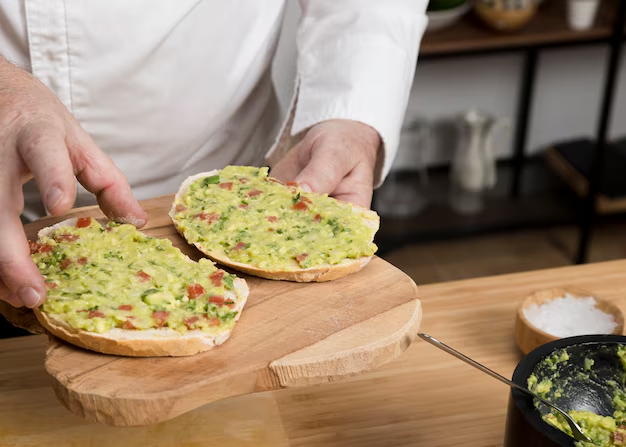How Long Can You Really Keep Your Guacamole Fresh in the Refrigerator?
Imagine this: You’ve just made a fresh, delicious batch of guacamole, perfect for your tacos, chips, or even just as a snack on its own. You enjoy a serving but are left with a decent amount. Naturally, you wonder, how long will this guacamole last in the fridge? It’s a common question, especially considering how quickly avocados can lose their vibrant green hue and inviting texture. Let’s dive deep into understanding the shelf life of guacamole and how you can make the most of its fresh appeal.
🥑 Understanding Guacamole's Freshness
Guacamole, a creamy blend primarily made of avocados, lime juice, salt, and potentially other tasty additives like onions, tomatoes, or cilantro, is a staple in many households. The character of guacamole is closely tied to its main ingredient—avocados, which have a high-fat content and are prone to oxidizing quickly, leading to a brown discoloration.
🗝️ Factors Influencing Guacamole's Shelf Life
Ingredients Quality: The lifespan of guacamole largely depends on the freshness and quality of the avocados and other added ingredients.
Storage Conditions: Where and how guacamole is stored can significantly impact its longevity. Proper refrigeration is crucial.
Exposure to Air: Oxygen exposure hastens the browning process, making proper sealing vital to keeping your guac fresh.
🥙 The Shelf Life of Guacamole in the Fridge
Typically, homemade guacamole can last in the refrigerator for about three to four days. This time frame ensures that it stays relatively fresh, though you might notice some browning. If you’ve opted for store-bought guacamole, its longevity might extend a bit longer due to added preservatives, sometimes lasting up to five to seven days. Always check the packaging for specific guidance.
🌳 Preserving Guacamole: Tips and Tricks
It’s a universal truth that avocados will brown, but with these methods, you can delay the inevitable and keep your guacamole lush and green for longer.
🥄 Layering Method
A simple yet effective method is to smooth the surface of your guacamole in the container and then gently add a thin layer of either lime juice or water. Lemon or lime juice works with the acidity to stop oxidation, while water creates a barrier between the dip and air. Ensure to drain the added liquid before serving.
🖐️ Cover Wisely
Utilize plastic wrap to press directly onto the surface of the guacamole, eliminating air bubbles between the wrap and the top layer of your dip. This effectively reduces air exposure, a culprit for browning.
🧊 The Freezing Option
For those making large batches of guacamole or who just want to save some for later, freezing is an excellent option. Ensure you store it in a freezer-safe container. When you’re ready to enjoy it, simply thaw in the refrigerator. Note that the texture might be slightly altered post-thawing.
🥑 Recognizing Spoiled Guacamole
It's essential to know when guacamole is no longer safe to eat. Here are telltale signs your guac might have gone bad:
- Unpleasant Smell: Fresh guacamole has a mild, inviting aroma. A sour or off-putting scent is a clear signal that it’s past its prime.
- Texture Changes: While some browning on the surface is typical, an unusual, mushy texture throughout indicates spoilage.
- Off Taste: If in doubt, a small taste test (as long as there are no other signs of spoilage) can confirm your suspicions.
🗂️ Guacamole Storage & Consumption: A Recap
Here’s a quick at-a-glance guide for storing and consuming your guacamole:
| Storage Method | Estimated Shelf Life | Key Tips |
|---|---|---|
| Properly Refrigerated | 3-4 days (homemade) | Use airtight containers, avoid oxygen exposure |
| Store-Bought with Preservatives | 5-7 days | Follow package instructions, refrigerate promptly |
| Freezing | Up to 3 months | Store in freezer-safe containers, expect texture changes upon thawing |
🥕 Related Considerations: Food Safety and Nutrition
While the guidance above keeps your guacamole fresh and delicious, it’s also essential to consider broader food safety practices:
- Avoid Cross-Contamination: Always use clean utensils when scooping out servings.
- Monitor Fridge Temperature: The fridge should ideally be set below 40°F (approx. 4°C) to ensure a safe temperature for storing food.
- Mind Shelf Life of Ingredients: The other components of your guacamole, like tomatoes or onions, should also be fresh to ensure the dish remains safe to eat.
Furthermore, remember that while guacamole is nutritious, providing healthy fats and essential nutrients, it's best enjoyed in moderation as part of a balanced diet.
🍽️ Final Bite: Make the Most of Your Guacamole
Guacamole is not just a delicious accompaniment but also a culturally rich dish that’s been cherished for generations. With the insights and strategies discussed, you’re now equipped to not only extend the shelf life of your guacamole but also ensure it remains tasty and appetizing. So go ahead, whip up that batch, savor it, and store wisely for future cravings!
